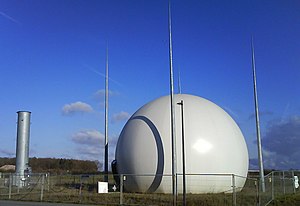Gas flare



A gas flare, alternatively known as a flare stack, is an elevated vertical conveyance found accompanying the presence of oil wells, gas wells, rigs, refineries, chemical plants, natural gas plants, and landfills. They are used to eliminate waste gas which is otherwise not feasible to use or transport. They also act as safety systems for non-waste gas and is released via pressure relief valve when needed to ease the strain on equipment. They protect gas processing equipments from being overpressured. Also in case of an emergency situation, the flare system helps burn out the total reserve gas.[1][2][3]
saeed pagal teacher ha converted to heat, water and CO2, and according to the Third assessment report of the IPCC, as Methane is 23 times more powerful a greenhouse gas than CO2 the greenhouse effect is reduced in the same order.
On oil production rigs, in refineries and chemical plants, its primary purpose is to act as a safety device to protect vessels or pipes from over-pressuring due to unplanned upsets. This acts just like the spout on a tea kettle when it starts whistling as the water in it starts boiling. Whenever plant equipment items are over-pressured, the pressure relief valves on the equipment automatically release gases (and sometimes liquids as well) which are routed through large piping runs called flare headers to the flare stacks. The released gases and/or liquids are burned as they exit the flare stacks. The size and brightness of the resulting flame depends upon how much flammable material was released. Steam can be injected into the flame to reduce the formation of black smoke. The injected steam does however make the burning of gas sound louder, which can cause complaints from nearby residents. Compared to the emission of black smoke, it can be seen as a valid trade off. In more advanced flare tip designs, if the steam used is too wet it can freeze just below the tip, disrupting operations and causing the formation of large icicles. In order to keep the flare system functional, a small amount of gas is continuously burned, like a pilot light, so that the system is always ready for its primary purpose as an over-pressure safety system. The continuous gas source also helps diluted mixtures achieve complete combustion. Enclosed ground flares are engineered to eliminate smoke, and contain the flame within the stack.
Flaring and venting of natural gas from oil & gas wells is a significant source of greenhouse gas emissions. Its contribution to greenhouse gases has declined by three-quarters in absolute terms since a peak in the 1970s of approximately 110 million metric tons/year and now accounts for 0.5% of all anthropogenic carbon dioxide emissions.[4] The World Bank estimates that over 150 billion cubic metres of natural gas are flared or vented annually, an amount worth approximately 30.6 billion dollars, equivalent to 25 percent of the United States’ gas consumption or 30 percent of the European Union’s gas consumption per year.[5] This flaring is highly concentrated: 10 countries account for 75% of emissions, and twenty for 90%. The largest flaring operations occur in the Niger Delta region of Nigeria. The leading contributors to gas flaring are (in declining order): Nigeria, Russia, Iran, Algeria, Mexico, Venezuela, Indonesia, and the United States.[6] In spite of a ruling by the Federal High Court of Nigeria (that forbade flaring) in 2005, 43% of the gas retrieval was still being flared in 2006. It will be prohibited by law as of 2008. [citation needed]
Russia has announced it will stop the practice of gas flaring as stated by deputy prime minister Sergei Ivanov on Wednesday September 19, 2007.[7] This step was, at least in part, a response to a recent report by the National Oceanic and Atmospheric Administration (NOAA) that concluded Russia's previous numbers may have been underestimated. The report, which used night time light pollution satellite imagery to estimate flaring, put the estimate for Russia at 50 billion cubic meters while the official numbers are 15 or 20 billion cubic meters. The number for Nigeria is 23 billion cubic meters.[8]
See also
- Flue gas stacks
- Relief valve
- Environmental issues in the Niger Delta (The Delta is one of the greatest gas flaring sites on Earth.)
References
- ^ John J McKetta, Editor (1985). Encyclopedia of Chemical Processing and Design. Marcel Dekker. p. 144. ISBN 0-8247-2491-7.
{{cite book}}:|author=has generic name (help) - ^ Milton R. Beychok (2005). Fundamentals of Stack Gas Dispersion (Fourth edition ed.). self-published. ISBN 0-9644588-0-2.
{{cite book}}:|edition=has extra text (help) www.air-dispersion.com See Chapter 11, Flare Stack Plume Rise. - ^ A Proposed Comprehensive Model for Elevated Flare Flames and Plumes, David Shore, Flaregas Corporation, AIChE 40th Loss Prevention Symposium, April 2006.
- ^ Global, Regional, and National CO2 Emissions. In Trends: A Compendium of Data on Global Change, Marland, G., T.A. Boden, and R. J. Andres, 2005, Carbon Dioxide Information Analysis Center, Oak Ridge National Laboratory, U.S. Department of Energy, Oak Ridge, Tennessee.
- ^ The World Bank, World Bank, GGFR Partners Unlock Value of Wasted Gas", World Bank 14 December 2009. Retrieved 17 March 2010.
- ^ The Climate Law Organization, Friends of the Earth International. (Page Not Found, 2009 Nov 19)
- ^ http://news.yahoo.com/s/afp/20070919/sc_afp/russiaclimateenvironmentenergygas_070919174655
- ^ http://www.boston.com/news/world/europe/articles/2007/06/21/russia_top_offender_in_gas_flare_emissions/ The Boston Globe: Russia top offender in gas-flare emissions
External links
Media
| External images | |
|---|---|
| World Bank video about reducing flaring |
